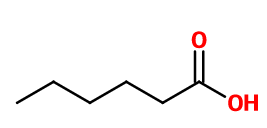
Photo credits: ScenTree SAS
Do you sell any of the raw materials? Would you like to let our users know?
Send an email to fournisseurs@scentree.coto learn about our advertising opportunities.
Do you sell any of the raw materials? Would you like to let our users know?
Send an email to fournisseurs@scentree.coto learn about our advertising opportunities.
General Presentation
-
CAS N° : 142-62-1
-
EINECS number : 205-550-7
-
FEMA number : 2559
-
FLAVIS number : 08.009
-
JECFA number : 93
-
Appearance : Oily colorless liquid
-
Density : 0,925
-
Volatility : Heart/Base
-
Price Range : €€
Physico-chemical properties
-
Molecular formula : C6H12O2
-
Molecular Weight : 116,16 g/mol
-
Log P : 1,75
-
Fusion Point : -3°C
-
Boiling Point : 205°C
-
Detection Threshold : 93 ppb à 100 ppm
-
Optical rotation : Donnée indisponible
-
Vapor pressure : Donnée indisponible
-
Refractive Index @20°C : Donnée indisponible
-
Acid Value : Donnée indisponible.
-
Flash Point : 102°C
Uses
Uses in perfumery :
Caproic Acid is used in very small quantity in cheese and lavender notes.
Year of discovery :
Data not available.
Natural availability :
Caproic Acid can be obtained naturally, as it is present in many plant extracts, such as Lavender EO, Petitgrain EO or Lemongrass EO. Therefore, it can be extracted from these essential oils by fractional distillation.
Isomerism :
Ethyl Butyrate is a constitutional isomer of Caproic Acid. Indeed, Ethyl Butyrate has a very butyric and cheesy note.
Synthesis precursor :
Caproic acid is the precursor for the synthesis of several esters called ''caproates '', by reacting it with an alcohol, in the presence of an acid catalyst.
Synthesis route :
Caproic acid is synthesized from chloropentane by a two-step reaction, by reaction with sodium cyanide, followed by hydrolysis.
Regulations & IFRA
Allergens :
This ingredient does not contain any allergen.
IFRA 51th :
This ingredient is not restricted for the 51th amendment

